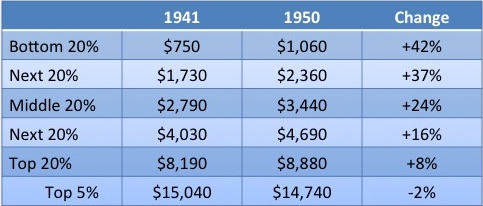We hear a lot about the “stimulus vs austerity” debate. The phrase (in quotes) gives more than half a million hits on Google. But that’s a crude, inaccurate way to think about our policies.
The fact is, we have both stimulus and austerity now. The stimulus is for the rich (the “job creators” who need endless tax cuts) and for big corporations. The austerity is for the rest of us (“hey, sorry, there’s no money to fund your school, because we had to help out the job creators”).
But it wasn’t always this way.
Check this out: This is how after-tax incomes changed from 1941 to 1950, by income bracket:
That’s a 42% increase in spendable income for the bottom 20%, compared to only a 8% increase for the top 20%. And the top 5% actually lost spendable income, even as the economy zoomed (first for the war, and then, after a break, as the peacetime expansion got going).
So back then, we had the opposite of today’s policies: Stimulus for the poor (lots of spending and low taxes), and austerity for the rich (high wartime taxes that were kept in place after the war).
And that should be our debate: not whether we need stimulus or austerity, but whether we need to switch the targets of the stimulus and the austerity.
I say “debate,” but the answer is really as obvious as anything in the economy can be. The current system stinks. The old system worked. We should go back to it.
And no, taxing the rich won’t magically kill the economy; high taxes on the rich actually correlate with good economic performance.
(Source for the table: Goldsmith S, Jaszi G, Katz H, Liebenberg M. Size distribution of incomes since the mid-thirties. Review of Economics and Statistics. 1954 Feb; vol 36. Quoted in Galbraith JK, The Affluent Society, Riverdale Press, 1958: p86.)

Leave a Reply